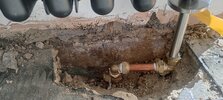Hi,
We live in a 1960's bungalow that we move in recently.
We got recommended local builder, who is doing rooms completely - plastering, painting, skirting boards etc.
One of the jobs was to replace old radiators for new ones, which involved modifying pipework in the concrete floor (btw, old pipework was just burried in concrete without any shrouds/insulation, surely that's not right?)
He has now spend two days trying to solder pipework but he says he can't do it as old pipes are too damaged and there's still some water left inside pipework. He tried getting the water out of the pipes but it's still there, it's steaming and messing up with flux, and breaking floor to replace old pipework is not an option
Unfortunately he doesn't have a tool to do a press-fit, so instead he installed lots of compression fittings which would be shrouded in foam pipe insulation and then pour concrete to make floor good.
It's a vented system, and he swears that it will be fine and won't leak.
I've attached picture for one of the rads.
Has anyone here had something like that done? I know it's not ideal but what would you do in this situation?
Thanks,
Jay
We live in a 1960's bungalow that we move in recently.
We got recommended local builder, who is doing rooms completely - plastering, painting, skirting boards etc.
One of the jobs was to replace old radiators for new ones, which involved modifying pipework in the concrete floor (btw, old pipework was just burried in concrete without any shrouds/insulation, surely that's not right?)
He has now spend two days trying to solder pipework but he says he can't do it as old pipes are too damaged and there's still some water left inside pipework. He tried getting the water out of the pipes but it's still there, it's steaming and messing up with flux, and breaking floor to replace old pipework is not an option
Unfortunately he doesn't have a tool to do a press-fit, so instead he installed lots of compression fittings which would be shrouded in foam pipe insulation and then pour concrete to make floor good.
It's a vented system, and he swears that it will be fine and won't leak.
I've attached picture for one of the rads.
Has anyone here had something like that done? I know it's not ideal but what would you do in this situation?
Thanks,
Jay
Attachments
Last edited:


